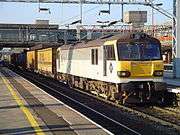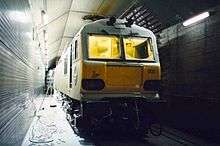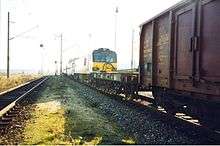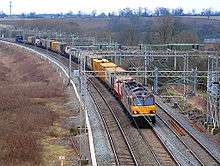British Rail Class 92
|
| |||||||||||||||||||||||||||||||||||||||||||
| |||||||||||||||||||||||||||||||||||||||||||
| |||||||||||||||||||||||||||||||||||||||||||
| |||||||||||||||||||||||||||||||||||||||||||
| |||||||||||||||||||||||||||||||||||||||||||
The British Rail Class 92 is a dual-voltage electric locomotive which can run on 25 kV AC from overhead wires or 750 V DC from a third rail. It was designed specifically to operate services through the Channel Tunnel between Britain and France. Eurotunnel indicates the Class 92 locomotive as the reference for other locomotives which railway undertakings might want to get certified for usage in the Channel tunnel.
Locomotives of this type are operated by GB Railfreight/Europorte 2 and DB Cargo UK. In France, a number were also owned and operated by SNCF; these were classified as CC 92000 on French railways.
The class 92 was intended as a mixed traffic locomotive for hauling both international freight trains and the ill-fated and never introduced Nightstar passenger sleeper trains though the Channel Tunnel. Since introduction the fleet was exclusively allocated to freight, however, in March 2015 six locomotives owned by GB Railfreight have begun passenger operations hauling the Caledonian Sleeper on behalf of Serco between London and Scotland, marking the very first use of the class in commercial passenger service.
Design
The fleet of 46 locomotives was built by a consortium of Brush Traction and ABB Traction. Parts construction was sub-contracted, with final construction and commissioning being undertaken at Brush's erecting shops at Loughborough between 1993 and 1996 (First unit was produced from 1992, and was finished in April 1993).
The bodyshells, shared with the Class 60 diesel locomotives but with a modified front end, were fabricated by Procor (UK)[3] of Horbury and delivered pre-painted in the then-standard triple grey livery.[4] Propulsion is provided by two ABB traction converters using GTO devices, with control via an ABB MICAS-S2. Maximum power is 5 MW (6,700 hp) on 25 kV or 4 MW (5,400 hp) on 750 V; with a tractive effort of 360 kN (81,000 lbf).
The locomotive is fitted with both rheostatic and regenerative braking, in addition to standard westinghouse air brake equipment. An electrical train bus is fitted to enable two locomotives to work in multiple formation, either double-heading or push-pull train with a Driving Van Trailer or DBSO.
To reduce the possibility of locomotive failure in the Channel Tunnel, most of the electrical systems are duplicated.
Operations
Prior to introduction to service, two locomotives (92001 and 92002) were extensively tested at the Czech Railway's test track at Velim near Kolín. One locomotive was temporarily moved from here to Vienna Arsenal for climatic testing.
The majority of the class are named after European composers and writers. Post-privatisation the ownership was split between EWS, European Passenger Services (Eurostar (UK) and SNCF.
During 2000 Eurostar (UK) offered their seven members of the class (92020 / 021 / 032 / 040 / 044-046) for sale being surplus to requirements with the non-commencement of sleeper services through the Channel Tunnel. However no buyer could be found[3] so they were decommissioned and stored at Crewe International electric depot. Five of these locomotives have now been purchased by Eurotunnel to be used by their Europorte 2 rail freight undertaking for short haul rail traffic in France.[1] In July 2011 Europorte 2/Eurotunnel purchased the five remaining locomotives that had belonged to SNCF, bringing Eurotunnel's total up to sixteen Class 92s.[5]
In 2009 a project was undertaken with the aim of allowing the class to be modified for operations on High Speed 1: i.e. with TVM signalling. The project received funding from the European Commission and it was anticipated services will begin in early 2010.[6][7] On 25 March 2011 for the first time a modified class 92 locomotive travelled from Dollands Moor to Singlewell using the TVM430 signalling system.[8] A loaded container train ran for the first time on 27 May 2011, and further trials with loaded wagons are planned until the end of June 2011.[9][10] In July 2011 a trial run of wagons carrying curtain walled swap bodies built to a larger European loading gauge was run from Dollands Moor, Folkestone to east London.[11] From 11 November 2011 a weekly service using European sized swap bodies has run between Barking, London and Poland using High Speed 1.[12][13]
The class is also notable in that the last train ever to travel under British Rail, the 2315 service from Dollands Moor to Wembley on 21 November 1997, was hauled by 92003 Beethoven.[14]
In April 2015, GB Railfreight commenced a contract to haul the Caledonian Sleeper. Class 92s haul it from London Euston to Edinburgh Waverley/Glasgow Central.[15] On 31 March 2015, the first Serco Caledonian Sleeper hauled by 92018 left London Euston for Scotland.
Liveries
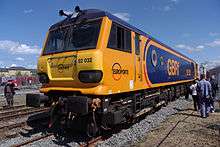
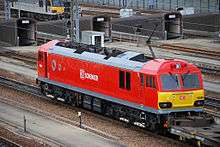
All units were originally painted in a simplified version of Subsector railfreight livery of two-tone grey livery, but with a dark blue roof the same shade as used on Eurostar trains.
To reflect their Channel Tunnel role, all were fitted with three 'O' shaped tunnel logos, each smaller than the next. Names were mainly blue stickers, but a limited number of locomotives gained cast nameplates. Only 92031 did not receive a name during construction, however it did gain one under EWS ownership.
The locomotives were fitted with Crewe Electric depot plaques to reflect their maintenance facility, and to reflect ownership, the nine SNCF owned machines had SNCF branding, six Eurostar owned locos had EPS (European Passengers Services) branding, with the rest having standard cast BR arrows under the drivers window reflecting British Rail ownership.
A number of Railfreight Distribution locomotives had "Railfreight Distribution" written along the locomotive side panels with a small RfD logo included.[16]
Following the privatisation of British Rail and the EWS purchase of Railfreight Distribution, the intention was to paint the RfD Class 92's into the EWS' gold and dark red colours. In the end, only two locomotives received EWS livery (92001 and 92031).[17] Locomotive no. 92001 had an additional three flags (English, Welsh and Scottish.) below the EWS logo on the cabsides, the only one so treated. The rest of the locomotives had a large EWS Logo applied halfway along the side.
Six Class 92s allocated to Eurostar retained their two-tone grey livery although there had been a plan to repaint these locomotives into Nightstar two-tone green livery. The combination of rail privatisation, technical problems, and the growth of point to point low cost airlines undermined the Nightstar venture, and the project was abandoned before a single revenue-earning service had even begun. The locomotives remained in two-tone grey until they were purchased by Europorte 2 in the 2000s. Europorte applied the designation "Europorte 2" inside a large Eurotunnel-style circle.
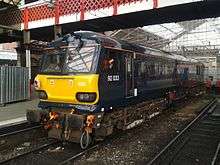
Following the takeover of EWS by DB Schenker, most of the fleet of Class 92s will likely move to DB Schenker Red liveries, matching that on previously repainted Class 66s. 92009 was the first locomotive to be outshopped in the new DB Schenker Red livery. The name "Elgar" had been removed;[10] and the locomotive was subsequently renamed "Marco Polo" later during August 2011.[18][19] The new livery has been completed on five locomotives (92009, 92015, 92016, 92031 and 92042).
In 2009, locomotive 92017 (formerly Shakespeare) was painted into Stobart Rail's blue and white livery and named Bart the Engine.
On 10 March 2011, locomotive 92032 appeared in the new Europorte GB Railfreight livery.[20]
In May 2014, Serco won the franchise to operate Caledonian Sleeper services for fifteen years from 2015, with GBRf to provide traction as part of its franchise bid.[21] In February 2015, 92033 was first to be released from Brush Traction after component refresh and subsequent repaint into a "Midnight Teal" livery. 92010, 92014, 92018, 92023 and 92038 have also gained the "Midnight Teal" livery, bringing the total number of locomotives now in "Midnight Teal" to six.
Fleet
| Number(year) | TOPS number range | Operators | Notes |
|---|---|---|---|
| 46 (1993–96) | 92004, 92008, 92009, 92011–92013, 92015–92017, 92019, 92022, 92029, 92031, 92035–92037, 92041–92042 | DB Cargo UK | 92009, 92015–92016, 92031, 92042 are in DB Schenker Red. 92017 is in Stobart Rail livery. All others are in British Rail two-tone grey. 92009, 92015–92016, 92031, 92042 to be converted for HS1 usage with the necessary TVM modifications.[22] |
| 92001, 92002, 92005, 92012, 92024, 92039 | DB Cargo Romania | 92012 (now 472 001 Mihai Eminescu), 92001 (now 472 002 Mircea Eliade), 92002 (now 472 003 Lucian Blaga ), 92024 (now 472 004 Marin Preda), 92005 (now 472 005 Emil Cioran), and 92039 (now 472 006 Eugen Ionescu) | |
| 92003, 92025-92027, 92030, 92034 | DB Cargo Bulgaria | ||
| 92006, 92010, 92014, 92018, 92020–92021, 92023, 92028, 92032–92033, 92038, 92040, 92043–92046 | GBRf/Europorte 2 | 92028 & 92032 are in GBRf/Europorte 2 Blue & Yellow. 92010, 92014, 92018, 92023, 92033, 92038 painted in Caledonian Blue for allocation to the Caledonian Sleeper. All others are in British Rail two-tone grey. |
Gallery
|
References
- 1 2 Development for Europorte 2: Eurotunnel buys five Class 92 locomotives
- 1 2 3 4 5 6 7 8 9 10 11 12 13 14 15 Marsden & Fenn 2001, p. 133
- 1 2 Morrison 2013, p. 95
- ↑ rolling stock : class 60 Archived 5 February 2012 at the Wayback Machine.
- ↑ "Eurotunnel's Rail Buy". Daily Express. 19 July 2011. Retrieved 2011-08-18.
- ↑ Sources:
"Class 92 modifications for HS1 freight" (PDF). Railway Herald (179): 3. 1 June 2009. Archived from the original (PDF) on 9 October 2011.
"Freight trains set to use High Speed 1". DB Schenker Rail. 16 April 2009. Archived from the original on 25 April 2009. - ↑ Freight trains set to use High Speed 1, Thursday 16 April 2009 rail.dbschenker.co.uk
- ↑ "European sized rail freight to arrive in the UK soon, following successful locomotive trial" (Press release). DB Schenker Rail (UK). 25 March 2011. Retrieved 6 May 2011.
- ↑ "DB Schenker Rail operates first freight train over High Speed 1" (Press release). DB Schenker Rail (UK). 27 May 2011. Archived from the original on 22 July 2011. Retrieved 27 May 2011.
- 1 2 "News Journal" (PDF). Railway Herald (269). 30 May 2011. p. 6. Retrieved 2011-07-15.
- ↑ "DB Schenker Rail operates first European sized freight train over High Speed 1", www.rail.dbschenker.co.uk, DB Schenker Rail (UK), 27 July 2011, archived from the original on 22 April 2012
- ↑ Katie Silvester (December 2011), "Rail Professional interview: Alain Thauvette", www.railpro.co.uk, Rail Professional, archived from the original on 20 April 2012
- ↑ "DB Schenker delivers first Poland to UK service", www.rail.dbschenker.co.uk, DB Schenker Rail (UK), 15 November 2011
- ↑ "EWS". Class 58 Locomotive Group. Retrieved 2009-03-30.
- ↑ "The Sleepers are stirring" Rail issue 756 3 September 2014 page 70
- ↑ Morrison 2013, p. 99
- ↑ Morrison 2013, p. 98
- ↑ Samuel, Amanda (18 August 2011). "Opening of the UK to European sized rail freight celebrated with locomotive naming". Rail.co. Rail Media Group. Archived from the original on 20 March 2012. Retrieved 2011-08-20.
officially name the locomotive 'Marco Polo'.
- ↑ "DB Schenker opens way for Continental sized freight trains". Logistics Manager. 18 August 2011. Archived from the original on 19 March 2012. Retrieved 2011-09-13.
Brian Simpson MEP, chair of the European Parliament's Transport and Tourism Committee officially named the locomotive "Marco Polo".
- ↑ "Weekly Pictorial" (PDF). Railway Herald (259). 14 March 2010. p. 24. Retrieved 2011-04-10.
- ↑ http://www.bbc.co.uk/news/uk-scotland-scotland-business-27599963
- ↑ Class 92 09/11/12 - wnxx.com (Retrieved 8 January 2013)
Sources
- Marsden, Colin J.; Fenn, Graham B. (2001). British Rail Main Line Electric Locomotives (2nd ed.). Oxford Publishing Co. ISBN 9780860935599. OCLC 48532553.
- Morrison, Gavin (2013). AC Electric Locomotives in Colour. Ian Allan. ISBN 9780711035058. OCLC 812686430.
Further reading
- "Class 92s start work on WCML 'Enterprise' trains". RAIL. No. 332. EMAP Apex Publications. 3–16 June 1998. p. 46. ISSN 0953-4563. OCLC 49953699.
- "A Class 92 finally works a service passenger train!". RAIL. No. 339. EMAP Apex Publications. 9–22 September 1998. p. 48. ISSN 0953-4563. OCLC 49953699.
External links
| Wikimedia Commons has media related to British Rail Class 92. |
